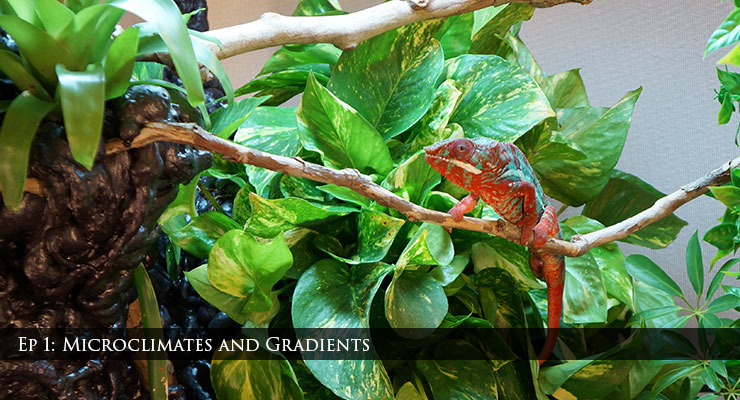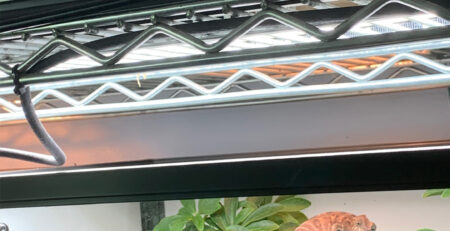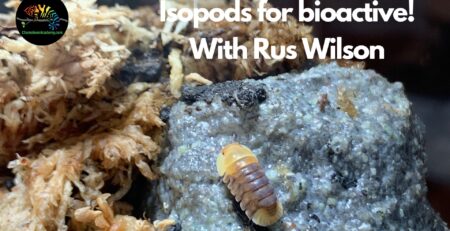Ep 1: Microclimates and Gradients
Summary: In this introductory episode we discuss the strategy to create a successful chameleon environment. By combining the correct caging with carefully planned placement of branches, plants, lights, and misting nozzles we can construct an environment with microclimates and gradients that give our chameleons the choices they need to regulate their own conditions for a happy life. .
You can listen here:
Show Notes
Cages mentioned in this episode:
We discuss different cages which are appropriate for different environments. I specifically addressed the controversy over glass cages. Listen to the podcast for the details on this. The bottom line is that glass cages come with the advantage that they can hold in heat and humidity and mist very well. That was their black eye early on but with special vents that are installed in some terrariums glass cages can be used. Glass cages have the disadvantages of 1) weight, 2) breakage, and 3) no external drainage easily had. If you need the heat insulation then you’ll have to figure out a way around these disadvantages. The glass terrariums mentioned in the podcast were from Zoo-med and Exo-Terra. The challenge with glass is that is does not commercially come in sizes appropriate for most chameleons, but these two companies have 36″ tall terrariums which is the bare minimum for most adults.
Zoo-Med 36″ tall Skyscraper Terrarium
Exo-Terra 36″ x 18″ x 36″ Large, X-Tall Terrarium
If you do not need the heat insulation, but you want to hold in the humidity and the misting from getting on the walls and furniture, the Dragon Strand Hybrid cage is the way to go. It is 48″ tall and has white PVD sides with an acrylic front. This has the advantage of retaining the light weight of the cages which allows us to make larger cages which are more chameleon appropriate. These cages have the option of external drainage which is a huge deal in chameleon keeping.
Dragon Strand Tall Hybrid Cage System
I do not understand caging companies that offer only a substrate tray (a tray that goes on the inside of the cage). Have these people ever kept chameleons? Mixing water, poop, and feeders together is a hygienic nightmare. I know their marketing strategy is cheap price, but I cannot figure out why they took that short cut.
Do-It-Yourself Mist Retention Walls for Screen Cages
(That don’t look hokey)
We in the community have long done the kludge where we keep mist and humidity inside a screen cage by wrapping it with a shower curtain or plastic wrap. This is effective, but looks pretty hacked together. If you would rather make your screen cages work instead of buying a cage designed to hold in humidity and mist and you would like it to look less hacked together then consider these reed fence panels found at home improvement stores. Glue/attach your plastic to the outside of this reed fence panel cut to size. Then when you wrap it around your cage you have a naturalistic scene. Here is a link to one of many products that will fulfill this task.
Transcript (more or less)
Transcript (More or Less)
Note: The Chameleon Breeder Podcast changed the name to The Chameleon Academy Podcast in 2020. This ties together the outreach efforts that grew from this original podcast. Although the audio mentions the Chameleon Breeder name, the links here in the show notes have been updated.
Welcome to the Chameleon Breeder Podcast, the only podcast dedicated to chameleons. This is episode 001. If you are new to podcasts then you are in for a treat. This is essentially radio on demand. Have you ever wished that you could learn about chameleons while you were driving or doing gardening? Well, that is the beauty of podcasts. Now you can! Of course, we chameleon keepers have regular duties of cleaning cages and taking care of feeders. Make it a cage and feeder cleaning date every weekend when this podcast comes out. Structure is a good thing for completing chores! And, by he way, if you are new to the world of chameleons when we use the term “feeders” we are talking about the insects that we feed to our chameleons. You’ll find that we are just as fastidious with our feeders as we are with our chameleons. Our chameleons are what they eat!
We have our Facebook page “Chameleon Academy Podcast” and are on instagram. You can interact with us in between episodes on social media. I’ll post show snippets and announcements there so you can always know what is going on. You can find the links to the social media spots at our website chameleonacademy.com.
To kick this off I’d like to talk about how we should approach cage set-ups for our chameleons. We all want to do what is best for our chameleons, but it is a challenge, and takes some practice, to look at the world through a chameleon’s eyes. Luckily, our chameleons will communicate through their actions as to how happy they are with their cages. It is pretty simple. If your chameleon is climbing the sides of the cage or hanging from the top panel there is something they are not content with going on. If they are constantly “exploring” the cage, there is something to switch up there. It could be something physical such as an uncomfortable temperature. It could be psychological such as a sense of insecurity. A content chameleon will find a couple of favorite spots and settle in. They develop a standard routine with a favorite sleeping spot or two, basking area and day time hang out. Give them a couple days to get used to a new cage, but after that, constant restlessness is a warning sign.
So how do we make for a content chameleon? The answer is to create not only microclimates, but also gradients between them. We want to give our chameleons the most choices in different temperature, humidity, and such as possible.
But let’s define some terms first here. A microclimate is a small area that has a certain temperature, humidity, UVB exposure, and protection from wind, rain, or prying eyes. For example, in my heavily planted outdoor cages it can be a toasty 90 degrees Fahrenheit outside, but down by the heavily shaded moist dirt floor the shade and humid ground it can be downright cool. This is a microclimate I created to give my chameleons a choice between warming and basking in the sun or retreating to a leafy cave to wait out the afternoon heat. Which one does my chameleon like best? Well…Both! Just at different times. In the morning he wants to warm up so will venture out into the direct sun. Once warmed up, he wants to be protected from the blasting sun so he retreats into the foliage. The important thing is that you provide a number of these spots so your chameleon can choose which microclimate they want to be in at any given time.
As a side note, microclimates are one reason why you need to be careful if you are investigating the natural conditions of your chameleon by referencing the official temperature of the nearest city. The weather report gives very generalized information so do not take it for more than that. If the temperature in Ambanja, Madagascar says it is 95 degrees, be careful not to think your cage needs to be 95 degrees to accurately reflect your panther chameleon’s home conditions. Those chameleons in the wild may very well have found some microclimate 10 degrees cooler or found a pocket of high humidity which helps chameleons weather higher temperatures. Or you could be seeing a weather pattern that is thinning out the population of weaker members. It is good and educational to reference weather patterns from the home town. Just understand what the numbers are – a small piece of the big picture – and use them appropriately.
Gradients. A gradient is a progression from one extreme to another. The most obvious is temperature. If you have a heat lamp in the top corner of your cage your temperature gradient goes from the temperature of the closest perching spot to that bulb to the perching spot furthest away from the bulb. In a large enough cage, outfitted with branches to take advantage of the space, that lowest temperature level will be the ambient room temperature. By the way, do not consider the screen walls of your cage to be perching or climbing areas. Screen walls are poor climbing or perching surfaces. Don’t make your chameleon use them to get what he (or she) needs. So your temperature gradient may be, for example, from 95 to 75.
The power behind giving your chameleon this range to choose from is that you give the chameleon the opportunity to regulate his own temperature. As the day and night temperatures fluctuate your chameleon will need to find different temperatures in his cage to be content. Remember that your gradient will change with the day and nighttime temperatures as well!
Now, I do have to bring up a note about more extreme conditions. If you are living in ambient conditions which are too cold for the species you are keeping then you have to consider solid side cages to hold in the heat. The colder the ambient temperature is the less space your gradient will be in. Having a 6 inch gradient from 95 to 75 obviously gives the chameleon only two choices and is like being by a campfire on a very cold night. Being close to the fire is too hot, but moving one foot back is too cold. You’ll need to lengthen your gradient using glass or other solid side cages which hold in heat.
If this is your situation you can either construct your own cage or look into Zoo-Med and Exo-Terra who have glass terrariums that have ventilation. At the time of this podcast, ZooMed has one and Exo-Terra has two chameleon appropriate sizes at 36” tall. I’ll link to these in the show notes. You’ll have solid glass sides which can hold in the heat. These are valuable characteristics in northern climates where it can be cold and dry.
Time for a quick side note: You have heard that chameleons need screen cages and anything else, especially glass will result in agonizing death of both your chameleon and anyone foolish enough to talk about it on social media. We can talk about this in more detail later, but the abridged edition is this. Stagnant air and trapped heat will stress a chameleon, result in a compromised immune system, and open the door to health issues including upper respiratory infections. These conditions are much harder to create in a screen cage which has led to the advice to use screen cages. Unfortunately, that advice has turned into a black and white sound bite which has demonized glass as a caging material. While aquariums were the culprit in the early days, there are many ways to ensure that a solid side enclosure does not result in stagnant air. Do-it-yourselfers hook up computer fans, ZooMed and Exo-Terra have vents at the bottom front of their terrariums creating convection currents and at Dragon Strand we use screen panels running the entire length of a wall. All these methods are used to incorporate the definite benefits of solids walls without the disadvantages. Solid walls and screen walls are just tools for us to use in different combinations to produce certain environmental conditions that allow chameleons to live in different geographical areas. Please don’t advise anyone on caging until you learn what their environmental conditions are. The internet has many advantages, but one trap is you have advisor nor advisee realizing that Florida advise is being given to someone in Canada.
Now, all this may be starting to sound overwhelming and complicated, but the execution of it is pretty simple. A nice perching branch in the upper right hand corner which has a heat lamp above it and a network of perching branches that end up in a leafy hiding spot outside the effective range of that heat lamp. Pretty simple. The commonly available Veiled and Panther chameleons do quite well with the ambient temperatures that we humans are comfortable with so if you are comfortable, they will be as well…with the option of the basking bulb during the mornings, at least.
But I don’t want to get too far into the details as to execution. That is another episode of its own! Let’s talk about the other gradients that are important to a happy chameleon.
First we have temperature which we have already covered. The second is humidity. Humidity is a very important element and, unfortunately, takes a bit more planning to get right. Chameleons have a higher tolerance to higher temperature with higher humidity so areas with hot, dry summers need to really pay attention. It would be great to create a sliding gradient of humidity for your chameleon to choose the perfect spot, but in the relatively small area of a cage, the best we can usually do is shoot for humidity pockets. These can be created by live plants, solid walls, and, for more experienced keepers, a substrate. And I say “more experienced keepers” as creating and maintaining a proper substrate for a chameleon adds another level of complication that a beginner shouldn’t mess with. Live plants give off humidity and creating a “glen” of sorts with plants can produce a humidity pocket. Especially if you create this with a large, thick hanging vine like a pothos suspended high up in the cage. Having a perching branch behind that wall of leaves underneath the drainage of the pot will give a nice humid retreat. The biggest challenge with humidity is our all screen cages. You just can’t hold in humidity in a screen cage. You’ll either have to go with a premade cage with solid sides or make your own solid sides. If you want a solid side on a screen cage then hanging a plastic tarp or shower curtain cut to size over two or three sides of your cage will do it. If you would like something a bit more aesthetic then line one of those reed fences with the plastic tarp and you’ll create a more natural looking humidity barrier. There will be a picture in the show notes if you aren’t sure what I am talking about. You can also hang cork bark panels, but you’ll have to construct a support wall and we are starting to get complicated! But I would be very interested in the different ways you all have retrofitted a solid wall to your screen cage. Send me images to bill@chameleonbreeder.com or post them to our Facebook and I’ll include them with the show notes so future listeners can get ideas.
If all that sounds like a lot of work or you want a more professional looking presentation you can go with production solid side cages.
The glass terrariums from Zoo-med or Exo-Terra discussed before will do the job quite nicely of holding in humidity and misting spray. The ability to line the glass walls with cork panels further helps the humidity issue. But if you do not need the heat insulating properties of glass I would steer you towards the Dragon Strand Breeder series with white PVC walls or the Clearside clear PVC walls. Glass has the advantage of being better at holding in heat, but glass terrariums have the following three major disadvantages:
1) Weight: Glass gets VERY heavy. The 18” x 36” x 36” Large, Extra Tall ExoTerra terrarium weighs a whooping 92 pounds.
2) Breakage: Shipping is difficult and prone to having to return a number of times, but that one time inconvenience shouldn’t sway a decision if you need glass. You do retain the danger of breaking the glass anytime you have to move the terrarium so be careful.
3) The most serious long term issue is Drainage: You have none. You will have to create a drainage layer to deal with water and since there is no external drainage you are having to deal with water and poop together. Poop soup is a serious hygiene problem. Adding drainage to a glass bottom is tricky, risky and labor intensive. Soaking up the water with a substrate adds a level of complexity that requires an additional skill that you should probably save for later.
Here is where the Dragon Strand Clearside enclosures should be considered as the 48” tall cage comes in around 14 pounds, is easily moved without fear of shattering, and comes with a number of external drainage options. The Dragon Strand cages have one entire side as a screen panel so you have a balance of sufficient ventilation versus humidity retention for most areas. And special orders are easy if you desire all clearsides. If you are in extreme temperature areas, you will have to bite the bullet and go for glass (or build your own cage). Most of you won’t have to do this though. As I said before, if you are comfortable in your home – meaning daytime temperatures get into at least the 70s – you can use the standard screen cages with retrofit plastic wrap or Dragon Strand Clearside cages.
Once you have a cage, or area of the cage, that can hold in humidity you can either create humidity pockets or you can add humidity using an external humidifier and direct it towards the cage direction.
So, in the end, I suggest creating a pocket of higher humidity in the enclosure and then work on the ambient humidity using humidifiers if you need to. As with all these parameters, each species will have its own humidity comfort level. Research your species. Veileds are much different than quadricornis. Remember that chameleon species come from areas as diverse as the sand dunes of the Namibia desert to traipsing across snow 13000 feet above sea level on Mt. Elgon. Figure out what your species needs!
So we have temperature and humidity. The next is UVB. This will be a short one. UVB doesn’t need to be a strict gradient, but it is good to make sure there is an area that chameleons can get out of it. In indoor caging this is usually not an issue. The effective range of our standard UVB bulbs is all of 12” and is crippled by simply going through the top screen panel. Your challenge in an indoor cage is to make sure there is a perching branch in the effective range of the UVB bulb. And as a side note, do yourself a favor and stick with well known UVB bulbs. UVB is dangerous and it is too easy to create new lamps which turn out to be dangerous. The T-8 tube lamps by Zoo-med and Exo-terra are pretty established.
This UVB gradient becomes much more of a serious enclosure design issue when placing your chameleon outdoors. All the temperature, humidity, and UVB gradients nicely laid out while your cage was sitting indoors just got blasted out of the water when you move that cage outdoors. The strength of the sun blasting down and now bouncing off the floor of your cage can cook your chameleon from top and bottom and be too much of a good thing. We do not know how much UVB is too much, but your chameleon does know. Make sure your chameleon can get out of the sunlight when the internal signals say to lay low. In indoor caging you’ll run into this issue with baby caging where the entire cage is fully within the effective range of your bulb and any time outdoors.
The fourth gradient is psychological. And that is the gradient of exposure or privacy. All animals need to have a place where they feel safe. We need to create an environment where our chameleon is able to escape constant scrutiny. This is a gradient which is unfortunately often overlooked. We tend to set-up our cages to our own desires which, in this case, is to enjoy our chameleon anytime we want to. It kind of defeats the purpose of having a chameleon if he hides in the plants, right? Well, kind of, but not really. If we bypass for a moment that a hiding place is vitally important to the health of your chameleon consider that allowing your chameleon to decide whether he is seen or not means that when he comes out it means that you have conquered his instinctual fear of anything bigger than he is. That is an accomplishment worthy of respect. But regardless of how much you desire a chameleon-on-demand set-up, your chameleon’s health requires a leafy retreat where he can feel hidden and secure. Even if he gets comfortable enough with you that he never uses it, the fact that he knows it exists helps him be that comfortable.
In the end, the often quoted mantra “get the biggest cage you can” is not because chameleons generally like to wander. It is because the bigger the cage the more and better microclimates you can create. The best thing you can do for your chameleon’s health is to give him a wide variety of choices regarding, temperature, humidity, UVB, and exposure. Within a properly set-up enclosure with these gradients and microclimates in place your chameleon will basically take care of itself. Add food, water and remove waste and you got it.
As far as podcasts go, the system is run by reviews and star ratings. If you liked what you heard today then you can support it by going to iTunes and leaving a review and star rating. It really makes a difference in how we are ranked and I love the feedback. You can also email me at bill@chameleonacademy.com and you can find show notes at chameleonacademy.com for the links we talked about. And that’s a wrap for today.













